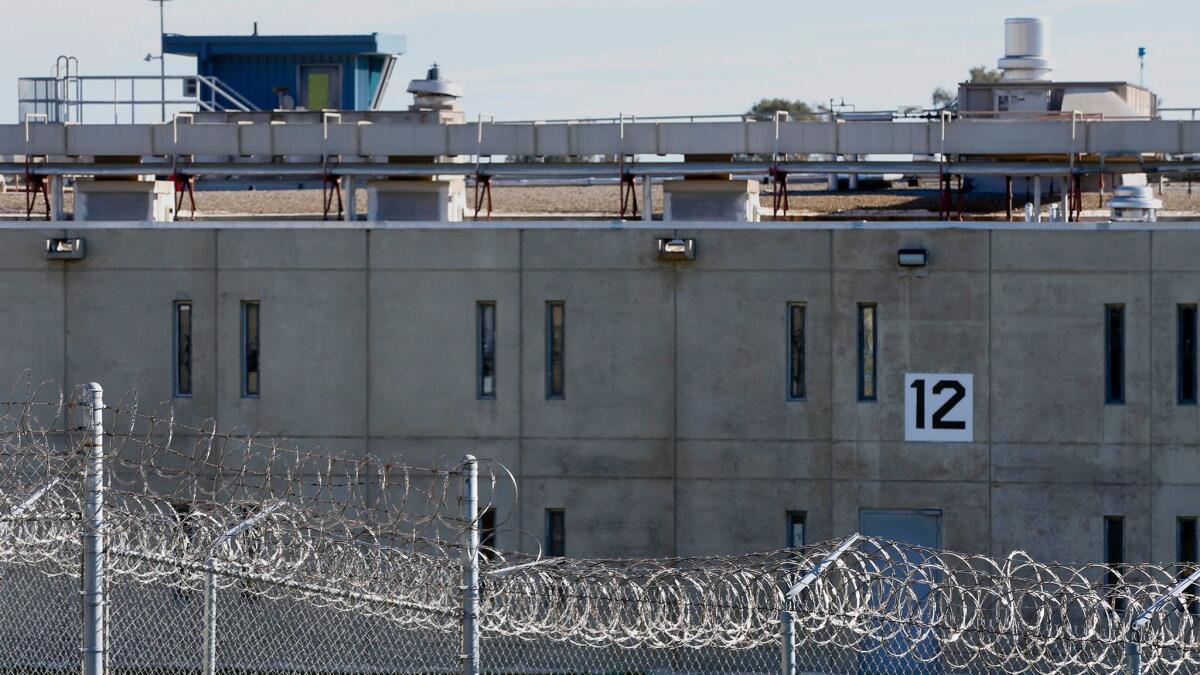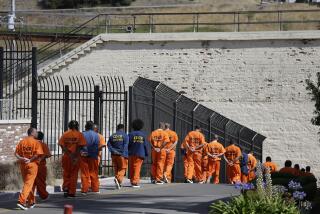How ‘schools not prisons’ became a favorite rallying cry for criminal justice reformers

A bill winding its way through the Legislature proposes a creative way to fund early childhood education: imposing a tax on companies that do business with California’s prison systems.
A tax on the “privilege” of such contracts, as Assemblyman Tony Thurmond (D-Richmond) puts it, is an unorthodox policy prescription. But by directly tying the state’s incarceration system to its education programs, Thurmond is treading familiar political territory.
The slogans vary: “Books not bars, “schools not prisons,” even “educate not incarcerate.” The messengers range from former Gov. Arnold Schwarzenegger to the rapper Jay Z. Increasingly, the rallying cry for prison overhaul is linked to education.
“There’s a natural nexus,” Thurmond said. “The fact that we pay so much for prisons — if we had spent just a portion of that on education, we would’ve prevented so many people from being incarcerated.”
Social science has consistently found data on education achievement — particularly drop-out rates — to be a strong indicator of who ends up behind bars.
The benefits extend to early childhood programs. A University of Chicago study released in December found that low-income children enrolled in high-quality child care programs tended to commit crime at a lower rate as adults.
“The research shows early investment is a better, more sound, more humane, more cost-effective investment. I just think that’s a fact,” state Sen. Holly Mitchell (D-Los Angeles) said.
Political Road Map: What does the state spend more money on, prisons or schools? »
Other factors, such as income, mental health and substance abuse, all figure prominently as drivers of crime. But schools, like prisons, are a major budget item for the state, making it convenient to compare the two.
“For Californians, the quality of the public education system has been a concern for a long time,” said Lenore Anderson, executive director of Californians for Safety and Justice, a nonprofit group advocating an overhaul of the criminal justice system. “It is front and center on the minds of voters that there are better things that we can do with this money.”
The idea that corrections and schools were in competition for scarce state dollars was embraced by Schwarzenegger, who grappled with prison overcrowding during his tenure.
“What does it say about our state — about any state that focuses more on prison uniforms than on caps and gowns? It simply is not healthy,” Schwarzenegger said during his 2010 State of the State address.
Schwarzenegger proposed an amendment to cap prison spending relative to higher education, but that soon fizzled. And while California has substantially reduced its inmate population under the order of a federal three-judge panel, state spending on corrections hasn’t similarly declined.
Thanks to the healthy state economy, “funding for education has improved as well as funding for prisons. We were able to have our cake and eat it too in this way,” said Joan Petersilia, a criminology professor at Stanford Law School. “We never had to run the test of whether or not we were willing to forgo prison spending in favor of education spending.”

Education for grades K-12 is the largest area of spending in the state budget, although a recent survey found nearly 40% of Californians thought prisons were the the biggest line item. In the current budget year, the state spends more than $71 billion on K-12 education, around $14 billion on higher education and $10 billion on corrections.
The prisons-versus-schools messaging figured prominently in the 2014 campaign for Proposition 47, which reclassified certain drug and theft felonies as misdemeanors.
“Prop. 47, California: Build more schools, less prisons,” Jay Z said at the start of a concert at the Rose Bowl that fall. The slogan was common on social media among the initiative’s backers.
The measure, branded the Safe Neighborhood and Schools Act, requires that savings from the declining prison population go to drug treatment, mental health and anti-truancy programs.
Schoolchildren are not the primary beneficiaries of those dollars. But Magnus Lofstrom, an expert on criminal justice with the Public Policy Institute of California, said by playing up the benefits for youth, criminal justice advocates are appealing to popular sentiment.
“There’s a broader acceptance of directing resources toward a population that’s maybe less responsible for their actions … as opposed to saying we need to help offenders convicted of a crime,” Lofstrom said.

Thurmond’s measure, Assembly Bill 43, is an attempt to turn the rhetorical link between schools and prisons into a fiscal one.
“The idea just hit me,” he said, “why aren’t we taxing those who profit off of incarceration to generate a new funding stream to pay for the services that we know make the most sense?”
Thurmond, who is running in 2018 to be state schools superintendent, is proposing a 10% tax on companies that provide goods and services, such as food, office supplies and reentry programs, to California’s prison system. His office estimates the tax would generate between $110 million and $170 million annually for early childhood education and after-school programs.
According to the California Budget and Policy Center, the state is spending around $3 billion this fiscal year on such programs.
The concept of finding new revenue dedicated to preschool and other child-care programs is “absolutely music to our ears,” said Moira Kenney, executive director of the First 5 Assn. of California, which represents the state’s county-level commissions that run early childhood development projects.
But as the bill faces its first committee hearing Monday, it will see steep hurdles with opposition from business groups.
“It unfairly targets the contractors that are providing goods and services to the prisons,” said Marti Fisher, a lobbyist with the California Chamber of Commerce, which branded the bill a “job killer.”
Fisher said the chamber supports funding for preschool and after-school programs, but added “this is not the way to get there.”
But Thurmond said his intent isn’t to harm prison contractors.
“This isn’t per se about punishment,” he said. “This is just about saying if you benefit from state dollars, why shouldn’t you also give back and contribute to helping to prevent the problem?”
Follow @melmason on Twitter for the latest on California politics.
ALSO
Prop. 47 got thousands out of prison. Now, $103 million in savings will go towards keeping them out
Prop. 47 puts state at center of a national push for sentencing reform
More to Read
Get the L.A. Times Politics newsletter
Deeply reported insights into legislation, politics and policy from Sacramento, Washington and beyond. In your inbox three times per week.
You may occasionally receive promotional content from the Los Angeles Times.







